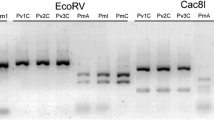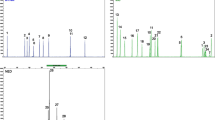Abstract
In this study, two new systems for species identification were developed based on size variation of mitochondrial DNA hypervariable regions among animals: one was a conventional method using non-fluorescent primer sets and agarose gel electrophoresis and the other was an automatic method using fluorescent primer sets and capillary electrophoresis. DNA samples from 18 mammal, four birds, and 19 fish species were amplified using three primer sets specific for mammals, birds, and fishes, respectively. The differences in the sizes of the polymerase chain reaction (PCR) products, ranging from about 350 to 900 bp, permitted us to identify species. These systems were successfully applied to various specimens from several criminal cases. In unknown samples, which were different in size from reference DNA markers, sequencing of the PCR products and subsequent BLAST analysis helped to identify species. Furthermore, the sequence data provided us with information on individuals. Because these species identification methods are very simple, easy, rapid, and exact, they are useful in the field of forensic science.



Similar content being viewed by others
References
Bataille M, Crainic K, Leterreux M, Durigon M, Mazancourt de P (1999) Multiplex amplification of mitochondrial DNA for human and species identification in forensic evaluation. Forensic Sci Int 99:165–170
Parson W, Pegoraro K, Niederstätter H, Föger M, Steinlechner M (2000) Species identification by means of the cytochrome b gene. Int J Legal Med 114:23–28
Branicki W, Kupiec T, Pawlowski R (2003) Validation of cytochrome b sequence analysis as a method of species identification. J Forensic Sci 48:83–87
Bravi CM, Lirón JP, Mirol PM, Ripoli MV, Peral-García P, Giovambattista G (2004) A simple method for domestic animal identification in Argentina using PCR-RFLP analysis of cytochrome b gene. Legal Med 6:246–251
An J, Lee MY, Min MS, Lee MH, Lee H (2007) A molecular genetic approach for species identification of mammals and sex determination of birds in a forensic case of poaching from South Korea. Forensic Sci Int 167:59–61
Linacre A, Lee JC (2005) Species determination: the role and use of the cytochrome b gene. In: Carracedo A (ed) Forensic DNA typing protocols. Humana, Totowa, pp 45–51
Wetton JH, Tsang CS, Roney CA, Spriggs AC (2002) An extremely sensitive species-specific ARMS PCR test for the presence of tiger bone DNA. Forensic Sci Int 126:137–144
Lee JC, Hsieh HM, Huang LH et al (2008) Ivory identification by DNA profiling of cytochrome b gene. Int J Legal Med. doi:10.1007/s00414-008-0264-0
Wells JD, Wall R, Stevens JR (2007) Phylogenetic analysis of forensically important Lucilia flies based on cytochrome oxidase I sequence: a cautionary tale for forensic species determination. Int J Legal Med 121:229–233
Balitzki-Korte B, Anslinger K, Bartsch C, Rolf B (2005) Species identification by means of pyrosequencing the mitochondrial 12S rRNA gene. Int J Legal Med 119:291–294
Melton T, Holland C (2007) Routine forensic use of the mitochondrial 12S ribosomal RNA gene for species identification. J Forensic Sci 52:1305–1307
Kitano T, Umetsu K, Tian W, Osawa M (2007) Two universal primer sets for species identification among vertebrates. Int J Legal Med 121:423–427
Imaizumi K, Akutsu T, Miyasaka S, Yoshino M (2007) Development of species identification tests targeting the 16S ribosomal RNA coding region in mitochondrial DNA. Int J Legal Med 121:184–191
Kocher TD, Thomas WK, Meyer A, Edwards SV, Pääbo S, Villablanca FX, Wilson AC (1989) Dynamics of mitochondrial DNA evolution in animals: amplification and sequencing with conserved primers. Proc Natl Acad Sci U S A 86:6196–6200
Murray BW, McClymont RA, Strobeck C (1995) Forensic identification of ungulate species using restriction digests of PCR-amplified mitochondrial DNA. J Forensic Sci 40:943–951
Wu H, Wan QH, Fang SG, Zhang SY (2005) Application of mitochondrial DNA sequence analysis in the forensic identification of Chinese sika deer subspecies. Forensic Sci Int 148:101–105
Tobe SS, Linacre AM (2008) A multiplex assay to identify 18 European mammal species from mixtures using the mitochondrial cytochrome b gene. Electrophoresis 29:340–347
Bellis C, Ashton KJ, Freney L, Blair B, Griffiths LR (2003) A molecular genetic approach for forensic animal species identification. Forensic Sci Int 134:99–108
Naito E, Dewa K, Yamanouchi H, Kominami R (1992) Ribosomal ribonucleic acid (rRNA) gene typing for species identification. J Forensic Sci 37:396–403
Lopez JV, Cevario S, O’Brien SJ (1996) Complete nucleotide sequences of the domestic cat (Felis catus) mitochondrial genome and a transposed mtDNA tandem repeat (Numt) in the nuclear genome. Genomics 33:229–246
Buroker NE, Brown JR, Gilbert TA, O’Hara PJ, Beckenbach AT, Thomas WK, Smith MJ (1990) Length heteroplasmy of sturgeon mitochondrial DNA: an illegitimate elongation model. Genetics 124:157–163
Wilkinson GS, Chapman AM (1991) Length and sequence variation in evening bat D-loop mtDNA. Genetics 128:607–617
Ishiguro N, Nakajima A, Horiuchi M, Shinagawa M (2002) Multiple nuclear pseudogenes of mitochondrial DNA exist in the canine genome. Mam Genome 13:365–372
Allen M, Engström AS, Meyers S et al (1998) Mitochondrial DNA sequencing of shed hairs and saliva on robbery caps: sensitivity and matching probabilities. J Forensic Sci 43:453–464
Gabriel MN, Huffine EF, Ryan JH, Holland MM, Parsons TJ (2001) Improved mtDNA sequence analysis of forensic remains using a “mini-primer set” amplification strategy. J Forensic Sci 46:247–253
Nelson K, Melton T (2007) Forensic mitochondrial DNA analysis of 116 casework skeletal samples. J Forensic Sci 52:557–561
Vilá C, Savolainen P, Maldonado JE et al (1997) Multiple and ancient origins of the domestic dog. Science 276:1687–1689
Savolainen P, Rosén B, Holmberg A, Leitner T, Uhlén M, Lundeberg J (1997) Sequence analysis of domestic dog mitochondrial DNA for forensic use. J Forensic Sci 42:593–600
Okumura N, Ishiguro N, Nakano M, Matsui A, Shigehara N, Nishimoto T, Sahara M (1999) Variations in mitochondrial DNA of dogs isolated from archaeological sites in Japan and neighbouring islands. Anthrop Sci 107:213–228
Pereira L, Asch BV, Amorim A (2004) Standardisation of nomenclature for dog mtDNA D-loop: a prerequisite for launching a Canis familiaris database. Forensic Sci Int 141:99–108
Angleby H, Savolainen P (2005) Forensic informativity of domestic dog mtDNA control region sequences. Forensic Sci Int 154:99–110
Eichmann C, Parson W (2007) Molecular characterization of the canine mitochondrial DNA control region for forensic applications. Int J Legal Med 121:411–416
Altschul SF, Madden TL, Schäffer AA et al (1997) Gapped BLAST and PSI-BLAST: a new generation of protein database search programs. Nucleic Acids Res 25:3389–3402
Nakahara H, Sekiguchi K, Imaizumi K, Mizuno N, Kasai K (2008) Heteroplasmies detected in an amplified mitochondrial DNA control region from a small amount of template. J Forensic Sci 53:306–311
Schneider PM, Seo Y, Rittner C (1999) Forensic mtDNA hair analysis excludes a dog from having caused a traffic accident. Int J Legal Med 112:315–316
D’Andrea F, Fridez F, Coquoz R (1998) Preliminary experiments on the transfer of animal hair during simulated criminal behavior. J Forensic Sci 43:1257–1258
Gupta SK, Thangaraj K, Singh L (2006) A simple and inexpensive molecular method for sexing and identification of the forensic samples of elephant origin. J Forensic Sci 51:805–807
Acknowledgments
We wish to thank Dr. Kazuhiko Imaizumi, National Research Institute of Police Science and volunteers for providing us with samples from dogs, cats, pigs, and cows. This study was supported in part by a Grant-in-Aid for Scientific Research (16590539) from the Japan Society for the Promotion of Science.
Author information
Authors and Affiliations
Corresponding author
Electronic supplementary materials
Below is the link to the electronic supplementary materials.
Supplementary Table S1
List of animals investigated in this study and the product size ± threshold value used for automated species calling (DOC 35.5 KB)
Supplementary Table S2
Nucleotide sequences of priming position and the size of product estimated from the sequences of animal D-loops (DOC 36.5 KB)
Supplementary Table S3
Haplotypes and sequences of mtDNA-HV in 82 dogs (XLS 25.5 KB)
Supplementary Table S4
Haplotypes and sequences of mtDNA-HV in 37 cats (XLS 36.5 KB)
Rights and permissions
About this article
Cite this article
Nakamura, H., Muro, T., Imamura, S. et al. Forensic species identification based on size variation of mitochondrial DNA hypervariable regions. Int J Legal Med 123, 177–184 (2009). https://doi.org/10.1007/s00414-008-0306-7
Received:
Accepted:
Published:
Issue Date:
DOI: https://doi.org/10.1007/s00414-008-0306-7




